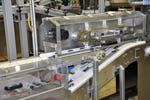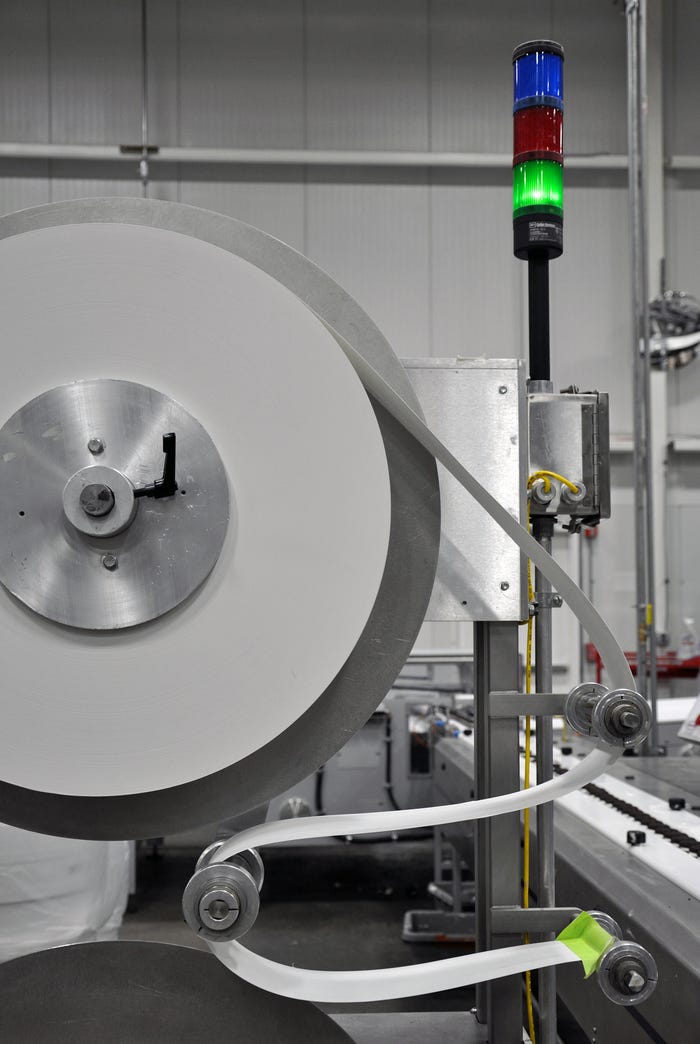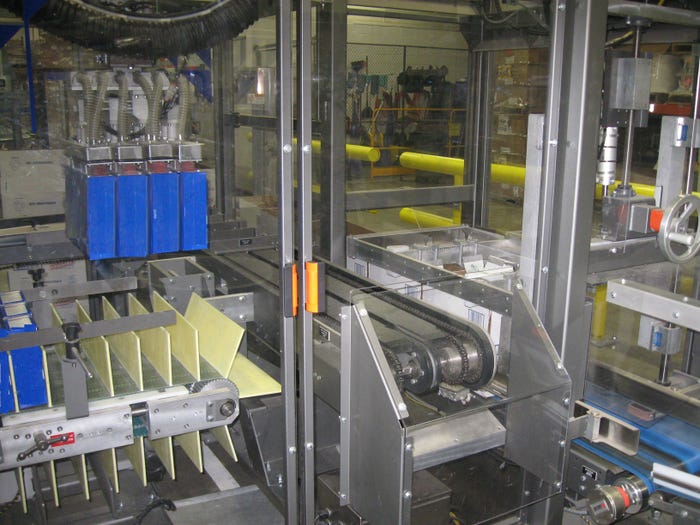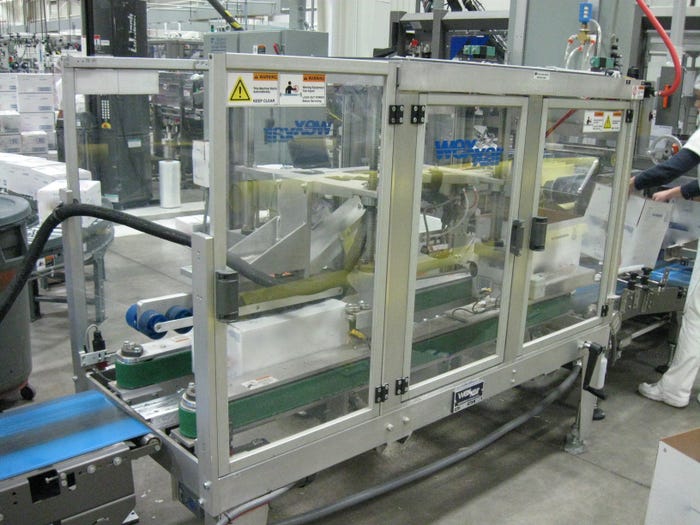Sophisticated packaging at bakery copacker
With 200,000 
O2L.jpg
sq ft of space, including four oven lines and one of the largest chocolate enrobing lines for baked goods in the U.S., Wenona, IL-based contract baker Oak State can produce 80 million lbs of baked product annually. The plant is divided into four distinct production areas: bars, cookies, chocolate enrobing and sandwich cookies, with dedicated packaging operations for each type of product.See accompanying story about a sophisticated conveyor system at Oak State Products that features a variety of conveyors, including overhead transport, that opens up space underneath the conveyors for packaging opertions.
Byron Goulding, vp-strategic planning, says, "We provide a range of packaging options, from individually wrapped to bulk packaging, giving our customers flexibility and choices for marketing their baked goods. However, individual, wrapped bakery products are the core of our business. We've strategically positioned ourselves to individual wrap on each line.
"Our customers are the largest in the world, and we partner with them to launch new products. We have a department that helps our customers design new packages, both from a design and functionality aspect, and they look to us for our expertise."
Sandwich soft cookies
During Packaging Digest's visit, Oak State was running 2-in. diameter cookies on its sandwich-cookie line. Cookie base-cakes are delivered from the oven to the packaging area on a wide belt conveyor. The base cakes are assembled into sandwiches and presented to the packaging system in aligned rows. The rows of cookies pass through a Thermo Fisher Scientific metal detector and then enter a lift table product-distribution system, which is used to continuously remove individual rows and transfer them to each wrapper leg. There are five identical wrapping lines positioned side by side, each running 220 packages/min.
Each wrapper leg includes an InFlight FT non-contact wrapper infeed from Benchmark Automation. This machine accepts a single lane of randomly spaced product and automatically delivers it on pitch to the wrapper flights. The InFlight FT Loader uses a floating belt-to-belt transfer system to "catch" each piece, eliminating the need to backlog product, which makes it suitable for fragile, sticky or narrow products. Wrapper speed is automatically changed based on the rate of product supply.
To start the process, a sensor at the inlet of the InFlight FT Loader monitors the cookies as they enter the system and adjusts the speeds of four short, in-line belts on the feeder t
O5.jpg
o maintain proper spacing so that the designated number of products enter each flight of the wrapper. During PD's visit, the line was placing two cookies in a package.The servo-driven belts change speed so that the floating nose of each belt catches the cookie as it enters the belt, thus providing exact spacing for the products to enter the flights of the wrapper.
Next, the products travel past the card sheeter, which has two rolls of card stock mounted on spindles. The servo-driven sheeter automatically cuts stock to the desired length from the roll in use and transfers the cut cards onto the wrapper infeed conveyor at the discharge of the feeder.
Benchmark makes card sheeters that automatically switch the operation from one roll to the other when the roll in use runs out, but Oak State does not have that unit. In their case, the operator manually switches from one roll to the other.
Timed product is placed onto cards now traveling in the wrapper flights. Benchmark Automation provided a completely integrated card sheeting system that is positioned in-line with the wrapper infeed, directly below the discharge of the InFlight FT Loader.
An interesting element of the Benchmark sheeter is that, although the rolls are mounted perpendicular to the conveyor, the card stock travels over a 45-deg roller so that it ends up traveling in the same direction as the wrapper infeed conveyor as the cards are cut and placed into the wrapper flights. This in-line position allows a smoother product transition onto the card and higher overall line speeds.
The cards are folded into a U-board as they travel in the wrapper infeed flights of a Model FW-3200 Formost Fuji Corp. horizontal wrapper. Oak State purchased the wrappers and shipped them to Benchmark, who combined the feeder, card sheeter and wrapper into an integrated system.
Wrapper automation
The products enter the flights of the horizontal rotary end-seal servo wrapper. As each cookie enters the infeed conveyor of the wrapper, a pusher lug attached to a chain comes up behind it and pushes it into the wrapping section. Two rolls of film are mounted overhead. Film pulled from the roll in use is formed around the cookie and a longitudinal fin seal forms a continuous tube around the product.
When that roll runs out, an automatic splicing system attaches film from the unused roll to the end of the film from the roll in use without operator intervention.
Brushes mounted
O3.jpg
on a continuous chain travel synchronously with the tube of film to hold the individual pieces in place as they travel to the horizontal rotary heating bars that seal and cut the film to produce individual packages. The film feed, fin sealer and end sealer/cutting head are servo-driven and are controlled by a PLC that is interfaced through a graphic HMI control panel. The servo drives and machine controls were supplied by Yaskawa America Inc.
The wrapper incorporates individually adjustable film spindles and tilting fin sealers that provide enhanced film control for tighter packages, and programmed software controls the seal temperature automatically to match the wrapping speed. An eye-mark reader tracks the film and adjusts the film travel to keep it in proper registration.
Once the operator programs the package length, operating speed and sealing temperatures for each product, this data is retained in memory. When changing to a different product, the operator simply selects from the product menu, and the machine changes to the new operating settings. The machine control automatically calculates the dwell time when the operator selects a product, but the operator can adjust the dwell time manually.
As part of its integration, Benchmark programmed the feeder/sheeter/wrapper system to change speed automatically to maintain a buffer of cookies entering the system from the oven. If this buffer falls below the set quantity, the system shuts down automatically. When the infeed-flow buffer is restored, it restarts.
Cartoner runs retail packages
During PD's visit, Oak State was producing retail cartons. For these cartons, packages from the wrapper go directly into a Model MK-LSP cartoner from AFA Systems Inc. Packages for convenience stores are diverted immediately after the wrapper onto a separate conveyor and are taken to the robotic case packaging area that will be described later.
Products enter the cartoner infeed lying flat and lengthwise on the conveyor. Oak State wants the packages to be on edge when they are loaded into the cartons so the machine incorporates a system to accomplish this realignment.
The packages are split into two lanes and are rotated so they are crosswise on the conveyor. Each lane feeds a revolving sprocket containing vanes. Each individual package transfers onto a vane, which revolves and discharges the package in a vertical alignment. Timing of this is critical, so the sprockets containing the vanes are driven by servo drives, which achieve precise speed regulation.
The system counts the number of packages and when the set number is present, it pushes them into a bucket that carries them to the loading zone of the machine. During PD's visit, the line was running 6-pack cartons. The line was loading two cartons at a time, so when 12 packages discharge from the rotating orienter, the servo indexes them into the loading zone.
Cartons are extracted from a magazine by vacuum cups on a rotating arm, and are delivered to the loading zone on a conveyor that runs parallel to the bucket conveyor transporting the packages of cookies. The carton feeder indexes faster than the product loader to ensure that there are always cartons available for loading. It idles when the conveyor is filled with cartons and restarts on demand when product arrives. The main drive of the cartoner and the carton feeder are servo driven.
A Videojet Technologies Inc. inkjet printer applies the production date and product code to an end flap as the cartons enter the machine.
Arms push the packages of cookies into the cartons as they travel on the conveyor. The flaps are sealed with a hot-melt unit from Nordson Corp.
Cartons go up an inclined conveyor to an overhead belt that transports them to the robotic case packing area. This conveyor is part of a complex system that collects products from all five wrapping lines and delivers them overhead to the case packing area. The accompanying article on p.44 describes this system, which was a major project for Oak State, in detail.
Cartons from all five lanes merge at the end of the overhead section and the single row of cartons go down an inclined conveyor and are transported to a robotic case packer from BluePrint Automation. The cartons are directed into three lanes as they enter the case packer and slide down chutes into vertical vanes on a conveyor indexing into the packer. Three side-by-side cartons slide into the vanes on each cycle, after which the conveyor indexes forward.
A gantry robot swings over and picks up the cartons in four lanes (12 cartons) with vacuum cups and swings back and places them into a shipper.
Cookies for c-stores
As mentioned previously, cookies for c-stores are delivered to a dedicated end-of-line operation on a separate conveyor system that does not use the overhead system. The c-store system incorporates three robotic tray loading cells that are equipped with Flex-Picker robots from ABB. Two of the cells run packages from two wrapping lines while the third cell runs packages from just one wrapping line.
Packages enter the cell from the two lines on parallel conveyors and a
O6.jpg
re diverted at a right angle into the flights of two picking conveyors. One package enters each flight. Each conveyor from a wrapper discharges into a dedicated flighted conveyor, so the cells serving two lines have two parallel flighted conveyors. This transfer is accomplished by short servo-driven conveyors. The flighted conveyor is also servo driven.
The Flex-Picker robot picks up eight packages at a time with suction cups and puts them into trays on a conveyor traveling between the two flighted conveyors. Since all of the sandwich cookie lanes are running the same product, the cookies entering the system are interchangeable. In normal operation, the robot alternates between the two flighted conveyors as it picks up the packages, but if there should be a stoppage on one of the packaging lanes, it will pick up the packages from the lane still operating to place in the trays, until the other line is back in operation.
The entire operation from the transfer of the packages into the flighted conveyor to the robot picking is controlled by the robot's controller. The robot knows the speed of the flighted conveyors and the tray conveyor and what packages it has picked up in each cycle, so it does not need a vision system to know where to pick up remaining packages.
After the trays are loaded, they are shrink wrapped and transported to the same robotic case packer that is used for the retail cartons. The operator tells the robotic packer whether it is running retail or c-store products and it adjusts itself to pick items from the correct infeed. The packer cannot run both styles of packages simultaneously, because there are some mechanical changeovers that must be made.
Oak State has installed a model WF30 case erector from Wexxar Packaging Inc. and a Wexxar top gluer to seal the filled shippers that are used for both types of products.
ABB Inc., 248-391-9000. www.abb.com/robotics
AFA Systems Inc., 905-456-8700. www.afasystemsinc.com
Benchmark Automation, 706-208-0814. www.benchmarkautomation.net
BluePrint Automation, 804-520-5400. www.blueprintautomation.com
Formost Fuji Corp., 425-483-9090. www.formostpkg.com
Nordson Corp., 770-497-3700. www.nordson.com
Thermo Fisher Scientific, 763-783-2500. www.thermo.com
Videojet Technologies Inc., 800-843-3610. www.videojet.com
Wexxar Packaging Inc., 604-930-9300. www.wexxar.com
Yaskawa America Inc., 800-927-529. www.yaskawa.com
About the Author(s)
You May Also Like


